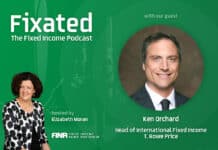
Global markets are displaying a risk-on approach, following the United States’ trade agreements with certain key partners and the reduction of risks associated with tariffs. However, uncertainty remains regarding the potential inflationary effect of tariffs, as companies determine whether to transfer increased costs to consumers.
In the global fixed income market, these uncertainties have had varying effects on the different types of fixed income. This year markets have been very buoyant and have absorbed much of the negative news, but we are starting to see cracks appear, including in fixed income markets. Investors should be aware of where these cracks are happening and how deep they could go, in order to reposition their portfolios for continued alpha generation as we head into the second half of 2025.
In the global fixed income market, these uncertainties have resulted in varying impacts across various types of fixed income assets. While markets have generally remained resilient this year and absorbed much of the negative news, some signs of strain are now evident, including within fixed income sectors. Investors should monitor where these developments are occurring and assess their potential significance to adjust portfolio strategies for the remainder of 2025.
Emerging market debt: Mixed results but resilient
Emerging market (EM) debt has experienced varied performance in recent months. Despite increasing macroeconomic uncertainties, EM debt has shown resilience, as indicated by ratings changes and supply-demand conditions. Some analysts note the possibility of growth in EMs compared to developed markets if there is a shift in investment from the US to EMs. Factors such as a weaker US dollar and expected monetary policy adjustments by some EM central banks are influencing current perspectives.
Although the US dollar experienced a rally in July, it remains significantly less expensive than at the beginning of the year, which continues to benefit emerging market borrowers. Carry traders have been utilising US dollar borrowings to finance higher-yielding investments across multiple markets, resulting in an accumulation of short positions on the dollar. The prevalence of these trades has increased as market volatility remained subdued. Nevertheless, should the US dollar continue to rebound, careful market selection will become ever more critical for those seeking outperformance.
Also read: Australian Economic View – September 2025 – Janus Henderson
A weaker US dollar combined with disinflationary pressures, resulting from declining oil prices and lower domestic demand, has led several emerging market (EM) central banks to reduce interest rates. This trend is notable among EMs in Asia. By the end of the year, it is anticipated that monetary easing will extend beyond Asia, as elevated real interest rates continue to limit economic activity, increasing the relative value of existing bonds for investors.
Investment grade credit: Cracks appearing in the hard data
Global investment grade credit spreads have seemed to be resistant to the series of headlines and risk events, coming mainly from the US. However, cracks are starting to show in the hard data, and there is increasing evidence that tariffs are eroding investor confidence and the spending ability of consumers across geographies.
US investment grade credit returned 0.15 per cent in July with spreads tightening by seven basis points. However, hard data released at the end of July has pointed to a weakening US consumer. There seems to be a real income squeeze in the US, where data is showing wage inflation falling, but core goods prices increasing.
Euro investment grade credit returned 0.50 per cent in July with spreads tightening by 13 basis points overall. The US-EU trade deal and defence relationships are yet to be ratified but we expect this deal to reduce the probability of further rate cuts by the European Central Bank.
Asia investment grade credit returned 1.3 per cent in July with spreads tightening by three basis points. Despite the Federal Reserve tightening and a stronger US dollar in July, Asian economies remain resilient. Tight credit spreads are not adequately compensating for the uncertain macroeconomic backdrop. We are also seeing demand for Asia investment grade credit as investors look to diversify into other parts of the world, particularly in Asia.
High yield credit: Positive returns and compression
Global high yield credit has delivered positive returns for investors despite macroeconomic uncertainties.
In the US, credit fundamentals for corporates remain robust, albeit with a slight decline in interest coverage. For US high yield credit, returns have been positive, and spreads have been tightening, indicating a favourable macroeconomic outlook. Fiscal stimulus and anticipated monetary easing are attracting investors, and more credits now yield below 7% due to spread compression and the addition of recently downgraded “fallen angels” (corporate bonds issued at investment grade and downgraded to high-yield by credit agencies).
European high yield credit remains positive with tightening spreads, buoyed by the recent EU-US trade deal and robust fundamentals, while Asia’s high yield market is also experiencing compression amid strong demand for new bond issues. However, the notable rally among weaker companies in Asia has sparked concerns of “market euphoria”, as investors may be overlooking the distinction between solid and distressed issuers. Given these developments, the current risk-reward trade-off appears less favourable, signalling the need for caution.
Investing in global fixed income
Global market uncertainty persists, and the extent of the impact of US tariffs on inflation and global markets is still unknown. While fundamentals in the global fixed income market remain generally strong, credit spreads should include an additional risk premium to account for this ongoing global macroeconomic uncertainty. As investors navigate through these times, special attention should be placed on the level of returns generated, direction of credit spreads and risk-reward premiums for each type of fixed income.
All information is current as at 21 August 2025 unless otherwise stated.

































